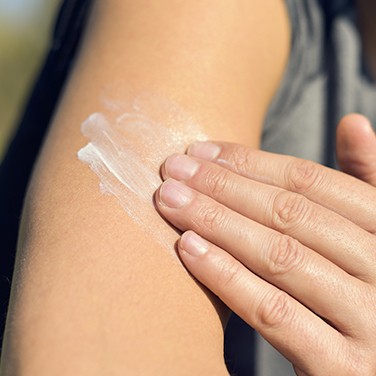3 Things You Should Know About Sunscreen
By Christina Phillis
As the days get longer and hotter, it’s a good time to read the latest thinking on sunscreen and brush up on the science behind it.
The sun constantly emits ultraviolet (UV) rays. UV rays, which are classified by their wavelength on the electromagnetic spectrum, have shorter wavelengths than visible light. The Earth’s ozone layer blocks many UV rays from the sun, except for UVB (the cause of sunburn) and UVA (which can cause longer-term skin damage, including skin cancer).
Sunscreens contain a combination of ingredients to help protect the skin from these harmful UVA and UVB rays. Inorganic ingredients, like zinc oxide or titanium oxide, reflect or scatter radiation. Organic ingredients, including octyl methoxycinnamate (OMC), absorb UV radiation and dissipate it as heat.
Despite what we already know about sunscreen and its benefits, research is uncovering new information for consideration.
Sunscreen in the Bloodstream
According to a pilot study conducted by the FDA, sunscreen ingredients are absorbed through the bloodstream at levels high enough to cause concern.
Oxybenzone was absorbed by the body at a concentration about 50 to 100 times higher than those of the other four chemicals being measured in participant blood samples. Other studies have shown a potential link between this chemical and hormone fluctuations in adult men, adolescent boys, and women, in whom it can cause shorter pregnancies and disrupted birth rates.
The blood concentration of avobenzone, oxybenzone, and octocrylene continued to rise with sunscreen use, and stayed in the body for at least 24 hours after the sunscreen use ended.
The FDA maintains that the results of this study should not discourage sunscreen use. However, more research is necessary to understand the effects of these chemicals.
SPF: How High Should You Go?
SPF, or sun protection factor, is the amount of UVB radiation a sunscreen provides as measured by the length of time it delays sunburn compared to unprotected skin. For example, a sunscreen with SPF 15 protects someone’s skin 15 times longer than no sunscreen. Because many sunscreens wear off throughout the day, dermatologists recommend that sunscreen be reapplied every two hours.
As the SPF number gets higher, the difference in protection becomes negligible. A sunscreen with an SPF of 100 blocks 99 percent of UVB rays, and a sunscreen with an SPF of 50 blocks 98 percent. “As you get higher and higher, it’s not really a practical difference,” David M. Pariser, MD, president of the American Academy of Dermatology told the New York Times. Many doctors are more concerned about how much sunscreen you’re using rather than whether the SPF number is high enough.
Sunscreen Ruining Coral Reefs
Research has shown that the world’s oceans absorb around 14,000 tons of sunscreen every year. According to some, this has a negative impact on marine life. Certain sunscreen ingredients are thought to contribute specifically to coral reef decline. Octocrylene (OC), a chemical found in sunscreen and also in some cosmetics and hair products, builds up in coral as fatty acid esters that can be toxic to the organism.
Sunscreens containing oxybenzone and octinoxate are believed to be so harmful to reefs that Hawaii is banning their use, effective January 2021. According to a study by Haereticus Environmental Laboratory, a nonprofit scientific organization, these chemicals cause bleaching, deformities, DNA damage, and ultimately coral death. The exposure is exacerbated by other stressors, including ocean acidification, water pollution, and rising sea temperatures.
As you navigate the sunscreen aisle this summer, take a look at all of the different options available and know the facts. What you put on your body eventually finds its way into the environment, where it can have far-reaching effects.
